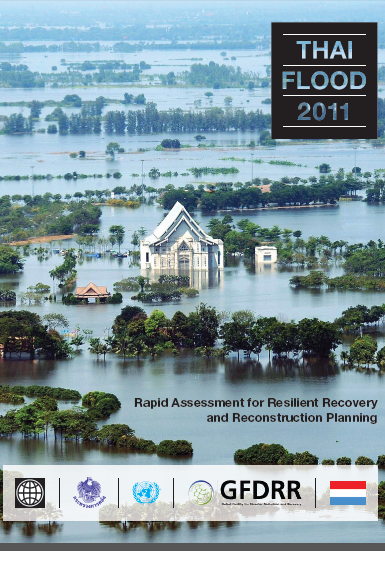
Thai Flood 2011
Rapid Assessment for Resilient Recovery
and Reconstruction Planning
©2012 The World Bank
The World Bank
30th Floor, Siam Tower
989 Rama 1 Road, Pathumwan
Bangkok 10330, Thailand
+66(0) 2686 8300
www.worldbank.org/th
This volume is a product of the staff of the World Bank with external contributions. The fi ndings, interpretations, and conclusions expressed in this volume do not necessarily refl ect the views of The World Bank, its Board of Executive Directors, or the governments they represent.
The World Bank does not guarantee the accuracy of the data included in this work. The boundaries, colors, denominations, and other information shown on any map in this work do not imply any judgement on the part of The World Bank concerning the legal status of any territory or the endorsement or acceptance of such boundaries. Rights and Permissions
The material in this publication is copyrighted. Copying and/or transmitting portions or all of this work without permission may be a violation of applicable law. The International Bank for Reconstruction and Development/The World Bank encourages dissemination of its work and will normally grant permission to reproduce portions of the work promptly. For permission to photocopy or reprint any part of this work, please send a request with complete information to the Copyright Clearance Center, Inc., 222 Rosewood Drive, Danvers, MA 01923, USA, telephone 978-750-8400, fax 978-750-4470, www.copyright.com.
All other queries on rights and licenses, including subsidiary rights, should be addressed to the Offi ce of the Publisher, The World Bank, 1818 H Street NW, Washington, DC 20433, USA, fax 202-522-2422, e-mail
This email address is being protected from spambots. You need JavaScript enabled to view it.
.
Cover Photographer: Christophe Archambault/AFP/Getty Images
Fordword
In 2011, Thailand suffered its worst floods in more than half a century. Caused by excessive and continuous rainfall from successive, powerful monsoons and subsequent, numerous dam breaches, the floods inundated more than six million hectares of land in 66 of the country’s 77 provinces, and affected more than 13 million people from July through December 2011.
In response to the disaster, the Royal Thai Government establis hed centralized flood monitoring and relief operations in mid-August, allocated extra flood-relief financial support to the affected provinces, and pledged investment in resilient recovery and reconstruction
for all impacted sectors.
In October, the Royal Thai Government, led by the Ministry of Finance, initiated an exercise to assess the economic and social impact of the floods and prep are recovery and reconstruction plans. This exercise was done in collaboration with the World Bank and various development partners. This Rapid Assessment for Resilie nt Recovery and Reconstruction Planning report is the result of the exercise which took place from November 4–25, 2011. Twenty-six of the country’s 66 affected provinces w ere included in the assessment, which examines 18 main sectors and used a comprehensive and internationally established methodology looking at damage and losses caused by the disaster. The report determines the country’s needs for post-disaster recovery and reconstruction and proposes short-, medium-, and long-term measures in each of the 18 secto rs for a sustainable post-disaster reconstruction program. Drawing on global good practices for disaster risk management and building-back-better strategies, the report also gives suggestions on how to improve the resilience of the country’s infrastructure and its communities to the impacts of disasters.
This report was made possible through the concerted efforts of government agencies, private sector partners, civil society organizations, and development partners. The speed with which such a comprehensive report was prepared is testimony to the remarkable dedication of a broad range of agencies and individuals, who ca me together as a team with one serious task at hand; to help the government of Thailand and its people form a full picture of the situation and the challenges ahead. There are many agencies and individuals whose great contributions deserve acknowledgement. This report, and the experience of producing it, will provide a strong foundation for the continued efforts of the government to develop a framework for strategic and rapid responses to future disasters and the integration of disaster prevention and mitigation efforts into a range of development activities for the benefit of the people of Thailand and the country’s future economic growth and prosperity.


































